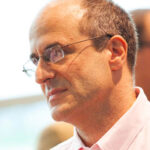In a previous roundup on A3 thinking I shared an overview of resources detailing the mechanics of problem-solving; lean companies (Toyota being the best-known example) teach individuals and teams the PDCA (PDSA/DMAIC/etc.) scientific model of thinking as a means of constantly improving by learning from the work at hand. Doing so calls for training, practice, and discipline; this piece shared a wealth of great resources from experienced individuals on what we call with lean shorthand “A3 Thinking.”
Producing problem-solvers at all levels is perhaps the essential quality of a complete lean enterprise, and so this piece builds on the prior by exploring Continuous Problem-Solving, or the way lean organizations build on isolated or episodic bursts of problem-solving to create an organization whose approach has a meta-problem-solving mindset; i.e. one in which the shared A3 approach to discrete problems extends to those of the organization. This new way of thinking about the work at hand is applied to the operating mindset of the organization itself.
Making such a transformation (perhaps the core challenge becoming and sustaining lean systematically) is no easy task, and often calls for counter-intuitive and radically different managerial choices. This is not your traditional way of thinking, or working. In his terrific column Want A Problem Solving Culture? Try Leading from the Middle, David Verble says that leaders can neither demand nor delegate this shared responsibility to think productively. Instead, a problem-solving organizational culture “must be created through the discretionary effort of every individual.” He says the lean idea of pull rather than push applies: “the work environment needs to be one in which employees feel a ‘pull’ to contribute to the common good and decide to respond to problems they see rather than ‘work-around’ them.”
Verble encourages managers to recognize that a top-down, one-size-fits-all approach will generally discourage rather than generate the types of behavior consistent with A3 thinking—that folks will not adopt this mindset through being told to do so but through direct practice over time. And he counsels managers at all levels to avoid the natural impulse to tell people what to do, and instead ask questions that they do not in fact already know the answers to. “You can take on the role as a manager or leader to create a safe zone where failure is allowed to happen and employees can experiment with improvements and countermeasures, and learn from the outcomes. That’s ultimately how we solve problems, and how we learn from problem solving.”
There many other practical tips for people seeking to help others become problem-solvers. Tracy Richardson’s One Simple Thing You Can Do To Improve Your Coaching reveals the power of taking the pressure off the learner. “Good coaching is about asking the right questions in an inviting manner,” she shares, noting that coaches who find a way to shift from making the talk about “you” to one about “I” focus everyone’s attention on work that can be framed in an improvable way (such as their standard work, or current state.) Small details like this play a large role in creating the right environment for spreading productive problem-solving.
Other excellent pieces build on ways to help others build their problem-solving chops. How To Get Out of the Habit of Telling by Katie Anderson recognizes the potential unintended consequences for lean coaches who develop personal habits of trying to fix the problem at hand, telling someone what they think they should do instead of focusing on doing what is needed to develop that person to solve the problem. She cites Margie Hagene of Thedacare, saying that “With the habit of telling rather than asking, you miss the ability to grow a culture of problem solving.”
Anderson elaborates on the need to avoid a fire-fighting approach that squanders the constant challenge to help others boost their capacity to learn. “In the moment, it can feel easier to ‘fix and move on’, but what these leaders are beginning to realize for themselves (through reflection via a personal A3) is that unless they intentionally reset their mindset and actively practice asking questions to support problem solving in others—they will continue repeating habits that aren’t helpful.”
Like other lean coaches, Anderson refers to the work of Edgar Schein, a leading thinker on organizational culture, in her Post. His approach of Humble Inquiry (asking questions you don’t already know the answer to) has gained enormous traction among lean thinkers. In Practical Guidance for Using Humble Inquiry in PDCA Problem Solving and Coaching, Verble explains how this open-minded inquiry by managers can successfully integrate with might appear to be its polar opposite, the concrete, analytic problem-solving based on a precise grasp of actual conditions as a means of generating powerful countermeasures attacking the determined root cause of a problem. He shares specific approaches for coaches to meld the two mindsets—and as a result generate a problem-solving culture that…creates problem-solvers.
Speaking of the wide impact of Schein, this Q&A from Jim Luckman contains a terrific list of books he recommends to support a transformational leadership. Schein is included in this useful list, as is Managing to Learn by John Shook. One that I find extremely useful in shifting one’s framing of this problem is Thinking in Systems by Donella H. Meadows — a terrific primer about how to tackle problem solving on a wide range of scales ranging from the personal to the global. Her great book recognizes that the organizations we tend to work in are complex in nature, with feedback loops and other dynamics that thwart the goal of simple outcomes (such as creating a culture of problem-solvers.) Her wise overview of how systems change provides powerful leverage points for managers hoping to move from the isolated benefits of having a few problem-solvers to the self-sustaining power of creating problem-solvers continuously.
Two other ambitious resources on this topic are Satoshi Hino’s Inside the Mind of Toyota, which shares a thorough overview of the elements of Toyota that build its ongoing capacity to learn; and Takahiro Fujimoto’s Competing to Be Really Really Good. Why this book? I’ll simply crib why from John Shook’s e-letter on Coaching.
How does personal transformation relate to the organizational side of transformation, Shook asks? He continues by saying:
Taka Fujimoto, the foremost scholar of Toyota in the company’s home country, distinguishes between competing through price or product with competing through organizational capability. In his book, Competing to be Really, Really Good, Fujimoto notes that capability building is in itself a process with three layers: routine work capability, routine improvement capability, and evolutionary capability.
“Capability building is a step-by-step process” he writes. “Organizational capability in regard to manufacturing comprises three layers. The base layer is routine manufacturing capability. That is the capability of producing the same product as competitors at lower cost, at higher quality, and with shorter delivery lead time.
“The second layer of organizational capability is routine improvement capability: the ability to achieve continuing improvements – kaizen – in productivity, quality, delivery lead times, and other facets of deep competitiveness. That capability consists of an organizationally ingrained capacity and predilection for undertaking problem-solving cycles continually, which drives relentless improvement in products and in production processes.
“Sitting atop routine manufacturing capability and routine improvement capability is the third layer: evolutionary capability; in other words, capability-building capability. That capability, anything but routine, is the capacity for tossing up new capabilities out of the soup of organizational chaos.”
Taka notes that gains are realized at different timeframes from these different processes – that capability-building is an “emergent process,” one whose pace cannot be rushed. Taka uses the phrase carefully to suggest “complex phenomena that arise from simple rules.” Through careful, mindful, repeated practice of specific methods, a systemic change occurs over time.






